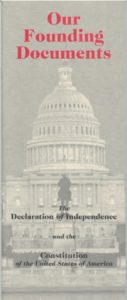Checks and Balances: Defending Liberty from Concentrations of Power
Editor’s Note: This article is part of a series written for The Epoch Times and its “American Promise” program. This article was written on November 5, 2021. Used by permission.
Guarding against a concentration of powers was a critical priority as the Founding Fathers created their framework for a new government. They were well aware of a long-held tenet of government: the accumulation of power by a single person or body of government is the greatest threat to liberty. With that, they wanted a system which would make it difficult for one person, party or group to gain control of the government. To this end, the Founding Fathers proposed a national government wherein power was divided between three separate branches: the Executive, the Legislative and the Judiciary.

Our Founding Documents – Cover
In Federalist No. 47, James Madison wrote “the accumulation of all powers, legislative, executive and judicia[l] in the same hands, whether of one, a few, or many, and whether hereditary, self–appointed, or elective, may justly be pronounced the very definition of tyranny.” This structure to avoid such an accumulation became known as the “separation of powers” as each branch was tasked with its own rules, responsibilities and powers. And in seeking to prevent misuses of power, the Founding Fathers also designed a system of checks and balances that encouraged the three branches of government to work together while also granting each branch the ability to check the power of the others. Hence, maintaining a balance in the government.
The Bill of Rights Institute offers this explanation in describing the theory of separation of powers versus its practical application. “While it is the legislative branch that makes law, the president may check Congress by vetoing bills Congress has passed, preventing them from being enacted. In turn, Congress may enact a law over the president’s objection by overriding his veto with a vote of two-thirds of both the House and Senate. The Supreme Court can then check both branches by declaring a law unconstitutional (known as judicial review), but the Supreme Court itself is checked by virtue of the fact the president and Senate appoint and approve, respectively, members of the Court. Furthermore, both the president and federal judges are subject to impeachment by Congress for ‘treason, bribery, or other high crimes and misdemeanors’ (United States Constitution: Article II, Section 4).”
Other examples of checks and balances include:
- The House of Representatives has sole power of impeachment, but the Senate has all power to try any impeachment.
- Any bills that intend to raise revenue must originate in the House of Representatives, but the Senate also has to approve the bill.
- Congress has the power to set and collect any taxes or duties.
- The president is commander-in-chief of the U.S. Army and Navy.
- The president has the power to grant pardons and reprieves for crimes against the U.S. except in an impeachment.
- The president can make treaties, but only with a two-thirds agreement from the Senate.
- The House of Representatives and the Senate both have to pass the same bill before it can become a law.
- The president can appoint Supreme Court judges, but the Senate must approve these choices.
- Supreme Court judges have the power to declare presidential actions as unconstitutional.
- The vice president is also automatically the president of the Senate.
- Congress can amend the Constitution, which means they can override a Supreme Court decision.
Disagreement perpetually exists regarding how well the checks and balances system works, but the constant tension and conflict between the branches is frequently beneficial to the citizenry as it denies an overwhelming accumulation of power by any one branch.
In recent administrations, both Democrats and Republicans have cried foul with regard to the opposing party attempting to subvert our separation of powers framework.
With eight years in office, President Barack Obama amassed an impressive assortment of Constitutional violations. Ilya Shapiro, a senior fellow in constitutional studies at the Cato Institute and editor-in-chief of the Cato Supreme Court Review, compiled lists of Obama’s top Constitutional violations for 2011, 2013 and then a final installment for 2015.
“One of Barack Obama’s chief accomplishments has been to return the Constitution to a central place in our public discourse,” Shapiro wrote in 2013. “Unfortunately, the president fomented this upswing in civic interest not by talking up the constitutional aspects of his policy agenda, but by blatantly violating the strictures of our founding document. And he’s been most frustrated with the separation of powers, which doesn’t allow him to ‘fundamentally transform’ the country without congressional acquiescence.”
With the 2013 list, Shapiro further noted how the president earlier in the year announced his new economic plans stating that “I will not allow gridlock, or inaction, or willful indifference to get in our way.”
President Donald Trump was also (and continues to be) accused of overstepping authority and abusing the separation of powers, however, the allegations lodged against him had a markedly different tone and context.
Writing in The Hill, Glenn C. Altschuler, a professor of American Studies at Cornell University, proclaimed President Trump’s assault on checks and balances: Five acts in four weeks. Of the five acts cited, four were related to the barrage of questionably motivated investigations perpetrated on the Trump White House throughout his administration. The other “assault” involved diverting Pentagon budget funds to instead be used for barriers on our southern border.
In his article, however, Altschuler explains how “citing an anti-narcotics law and a statute allowing the Pentagon — in the event of a national emergency requiring the deployment of troops — to use construction funds to pay for infrastructure for these forces, the White House made this decision without approval from Congress, which has several times refused to appropriate money for this purpose.“ He concedes though that “the courts have approved these maneuvers [emphasis added], but, along with the administration’s imposition of tariffs, they constitute yet another step in the evisceration of Congress’s power over the purse.”
The Washington Post echoed a similar narrative in Under a lawless Trump, our system of checks and balances is being destroyed. The Trump alleged lawless scenarios described centered on activities involving people like James Comey, Michael Flynn, Jeff Sessions, Robert Mueller, Lt. Col. Alexander S. Vindman and Roger Stone.
“Because the courts move slowly, the president discovered that he can sustain even the most egregious stonewalling and violations for years,” the op-ed by the paper’s (unnamed) Editorial Board concludes. “The remaining checks would be Congress, but Republicans have almost uniformly chosen subservience to Mr. Trump over fealty to the Constitution, and the executive branch, but Mr. Trump has sought to fire or cow anyone who would stand in the way of his lawlessness.”
Prior to the 2020 election, a Jewish Journal column by Gregory Smith warned that Democrats’ Proposals Are the Latest Threat to Checks and Balances.
Per Smith, “The genius of our Constitution is the concept of checks and balances. The President, the Supreme Court, and Congress each limits the power of the other. Legislation can be passed by the House and Senate, vetoed by the President, and challenged by citizens up to the Supreme Court. Our Founding Fathers designed the system to prevent the tyranny of an otherwise transitory faction which, without that restraint, can convert temporary popularity into permanent dominance. In many nations, the lack of checks and balances has enabled one-party rule, preventing the ascendancy of competing interests and ideas. The Democrats’ proposals threaten to do exactly that [emphasis added].”
Smith goes on to list Democrat proposals he believes would severely damage our country: admitting two new states (Washington D.C. and Puerto Rico) to the Union, elimination of the Senate’s filibuster rule and “packing” the Supreme Court.
With a wide array of opponents preparing to fight Biden’s vaccine mandate, its final disposition remains to be seen. The Biden administration is straining its authority with its potential support of the Protecting Our Democracy Act which would largely federalize elections which Constitutionally fall under state purview.
“The Founding Fathers were wary of a powerful central government that would oppress and restrict the liberties of individuals. Their experience under Britain’s tyranny made them determined to have a government ‘of the people’ and not by a ruling elite,” wrote Thomas Glessner, J.D., president and founder of the National Institute of Family and Life Advocates.
“Woven within this brilliant constitutional plan are checks that protect individuals from governmental tyranny and ensure that no branch of government can control other branches. Further, the balance of power between the federal government and the states preserves the ability of states to reflect their cultural heritage while maintaining a key part of the American republic.
“Historically, these constitutional checks have worked well to protect the rights of individuals while at the same time ensuring an effective national government.”
Indeed they have and all Americans must stay vigilant to ensure these checks and balances are protected for our future.
Lou Ann Anderson worked in central Texas talk radio as both a host and producer and currently hosts Political Pursuits: The Podcast. Her tenure as Watchdog Wire–Texas editor involved covering state news and coordinating the site’s citizen journalist network. As a past Policy Analyst with Americans for Prosperity–Texas, Lou Ann wrote and spoke on a variety of issues including the growing issue of probate abuse in which wills, trusts, guardianships and powers of attorney are used to loot assets from intended heirs or beneficiaries.

